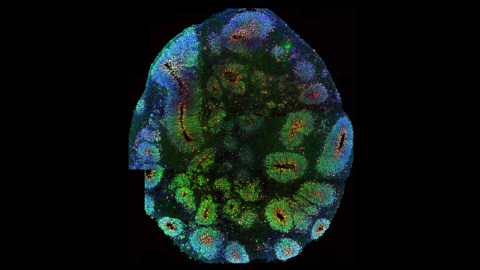Brazilian scientists produce mini-brains with eyes

- Mini-brains, or “neural organoids,” are at the cutting edge of medical research.
- This is the first one that’s started developing eyes.
- Stem cells are key to the growing of organoids of various body parts.
Organoids are tiny, self-organized tissue cultures. They’re comprised of stem cells that can be programmed to replicate naturally occurring tissue. Using them, scientists can grow mini organs of various types for research purposes, and, not surprisingly, there’s a lot of interest in mini-brains. Researchers from the D’Or Institute for Research and Education (IDOR) have announced the creation of one that includes retinal cells — primitive eyes.
Mini-brains
Neural, or cerebral, organoids begin with cells extracted from skin or urine cells of volunteers. These cells are converted into undifferentiated stem cells first, and then into neurons and other nervous system cells. Immersed in nutrient-rich fluid suspensions and carefully agitated, mini-brains emerge through a self-regulated process of agglomeration.
The resulting organoids “partly reproduce fetal brain development in vitro,” says earlier research from IDOR’s team, led by Stevens K. Rehen. Incomplete as organoids are, they nonetheless constitute “a demonstration that it is possible to repeat, in the laboratory, increasingly advanced gradients of human brain development,” he says. They provide a platform for studying normal brain development and brain disorders, and can serve as models for understanding pathologies — as they did for identifying the manner in which the Zika virus affects fetal brain development — no computer model or animal testing can address.

A: Image of an organoid with pigmented regions (bar = 1 mm). B: Box shows pigmented regions of organoid after 45 days (bar = 1 mm). C: Pigmented regions (bar = 500 μm)
(Rehen, et al)
Shaken, not spun
The IDOR team’s announcement is just a detail in a paper whose primary purposes was presenting an alternative methodology for growing these complex 3D structures, using an orbital shaker — a device that gently stirs liquid suspensions to promote cell-cluster aggregation — instead of the more expensive SpinΩ bioreactor. IDOR asserts that their shaker produces a similar reduction in shear as the lowest spinning velocities for the SpinΩ, while still effectively promoting the growth of complex organoids.
The mini-brains grown with IDOR’s process actually exhibited the presence of precursor cells for key architectures such as the forebrain, dorsal telencephalon, retinal cells and midbrain, and hindbrain in about 30 days. By 45 days, the organoids had “pigmented regions, which were previously described to reproduce the formation of retinal pigmented epithelium.” These regions tested positive for glycogen synthetase, an enzyme linked to vision. These regions are the mini-brains’ primitive eyes.
Just the beginning
Neural organoids are, so far, very simple, with no sensory inputs or outputs. It would be highly surprising if there was anything like consciousness present at this point. Obviously, though, as more complex neural organoids are developed — and the possibility of bodiless sentient individuals arises — ethical questions will abound including, first of all, whether or not the creation of consciousness is a boundary we should ever cross, assuming we one day know where that boundary might be. And if we do proceed, what rights would a mini-brain possess?





